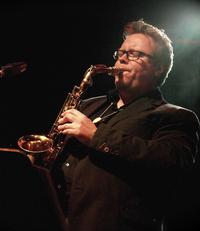
Jazz in Worship and Worship in Jazz – Exploring the Musical Language of Liturgical, Sacred and Spiritual Jazz in a Postsecular Age.
Short description
Dissertation by Uwe Steinmetz. (2021)
Sacred Music in all cultures of the world expresses ideas of what is sacred in the respective culture and shares transformative experiences of the holy or the transcendental within a ritualistic way of performing and listening. From a post-secular perspective, Sacred Music comments on the unspeakable, the unsayable depths and mystery of our human situation with an artistic language that opens a space for reflection, that spoken language is not able to provide.
Jazz music can express religious experiences through the use of a number of compositional methods: Pitch and rhythm, as well as a correspondence between the proportions of the music and the listener's body, are some of the factors. This dissertation from the Academy of Music and Drama identifies different methods for religious meaning-making in jazz.
Uwe Steinmetz’s doctoral dissertation is based on his own work as a saxophonist and composer, as well as his own Protestant-Christian faith. From music theoretical, religious-historical, theological and neurological perspectives, he examines both his own compositions and examples from modern jazz history since 1950. He notes that many musicians use a repertoire of musical “tricks” to create religiously inspired work.
“It's like a toolbox that the musician works with. It's about things like pitch, harmonics and rhythm. For example, a steady pulse in the music can correspond to the rhythms of the human body, that is, breathing, heartbeat and so on. In this way, the music can help to put the listener in a state of so-called flow. Neurological studies show that the sensation of 'flow' within improvising music leads to a similar experience as in repeating short prayers or mantras, a disconnectedness of temporal and spatial awareness and a 'transcendental experience'. Meanwhile, the use of very slow tempos may engage the imagination and help the music narrating a story, for example a musical illustration of eternity, says Uwe Steinmetz.
In total, he shows six separate compositional techniques used for religious meaning-making in jazz. In identifying these methods, he has been inspired by the American jazz musician and researcher George Russell. Uwe Steinmetz also describes factors that lie outside the composition itself. One example of this are various forms of storytelling that place instrumental music in a context. It can be in the form of a spoken presentation, but also by showing pictures or video during the performance.
Acoustics are yet another factor. The church room itself creates an acoustic context that musicians and listeners relate to.
“The long reverberation can also be recreated with the help of effect pedals so that the musician ‘carries the church room with them’, and thus reminds the listener of that context,” says Uwe Steinmetz.
Jazz as an art form has had strong ties to religiosity since its inception. Its roots are found partly in ritual music from the African-American diaspora, and partly in the Christian gospel music. One of the genre's most famous musicians, the saxophonist John Coltrane, devoted the latter part of his career to creating a musical language for religious meditation, his album A Love Supreme being one of the most well known examples.
“Meanwhile, jazz teaching has traditionally been about the craft, which notes you can play and so on. There has been very little room for conversation about how music can be made the bearer of a religious message for example, or how it can be used to enable the listener to experience a connection with something greater than himself. I hope my dissertation can contribute to that.” says Uwe Steinmetz.
Thesis title: Jazz in Worship and Worship in Jazz – Exploring the Musical Language of Liturgical, Sacred and Spiritual Jazz in a Postsecular Age.
PDF version available through the University of Gothenburg Library: https://gupea.ub.gu.se/handle/2077/68393
Contact:
Uwe Steinmetz
mail@uwesteinmetz.net
0049 - 173 731 6861
